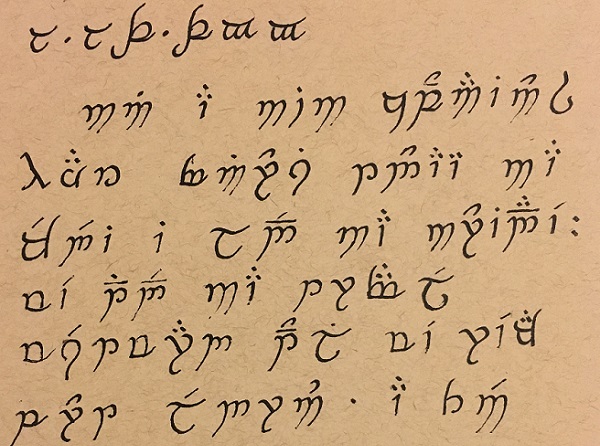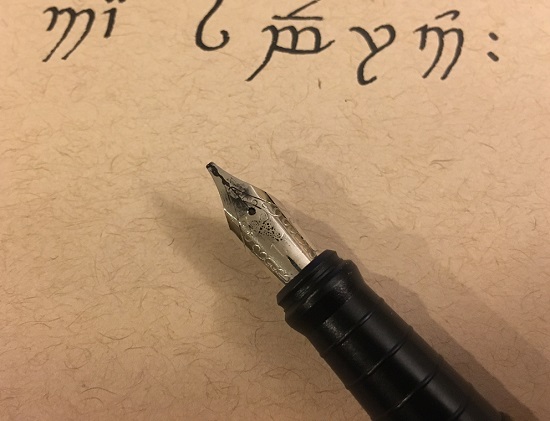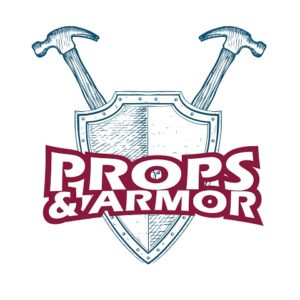
If you’ve ever decided that you want to make a prop for your game that’s written in Elvish, maybe something like a book or a journal, then you might not have realized at first how complex of a task it might be. Perhaps you were like me and searched online for things like, “How to learn Elvish” or “How to write in Elvish,” and then realized how deep the topic really is. What started out as a simple idea, to have a prop that uses Elvish writing, turned into the daunting prospect of learning a new language.
Luckily for you, you don’t have to actually learn the Elvish language in order to make some cool props that your players can use. If you wanted to do that you definitely can, but that’s a bit beyond the scope of this article. This article is about how to make a prop for your game with Elvish writing that looks convincing, and the different methods that I’ve found of doing so.
Levels of Authenticity
Before you make your prop, whether it be a book, journal, scroll, or any other item that has Elvish writing on it, you have to decide how authentic you want it to be. Chances are that if you just write some random letters that look Elvish, your players won’t be able to tell. However, you never know if one or more of your players have studied or learned some Elvish. Even if they haven’t, I think it’s likely that some of you game masters out there still want your props to be as authentic as they can be.
If you’re fine with just writing something that looks like Elvish, then your job is very simple. You can just look online for images of Elvish letters and copy them in random order onto your prop. This is by far the simplest, easiest, and fastest way to do it. If you don’t have much time to make your prop, then you might want to go with this method. It’s perfectly sufficient, and your players probably won’t be able to tell the difference.
If you have a bit more time though, and you want your prop to have a bit more authenticity, then let’s dive a bit deeper into this topic. If you’re like me, then it doesn’t really matter if your players will be able to tell if the Elvish makes sense or not.
Different Types of Elvish
When most people think of the Elvish language, they probably think of the languages developed by J.R.R. Tolkien for his books. While that is probably the most well developed Elvish language system, it’s not the only one in existence. Many other forms exist in movies, video games, and other books. Tabletop games like Dungeons and Dragons and Warhammer also have their own versions of Elvish, with their own alphabets. If you don’t want to use Tolkien’s Elvish, then you might want to look into those alternatives.
In my opinion though, Tolkien’s elvish is the most complete form of Elvish, because of it’s large vocabulary that has been expanded even after his death by his fans. There are even multiple dialects of Elvish in Tolkien’s system, with the two main ones being Quenya and Sindarin. Those two even have their own subdivisions of dialects. Tolkien treated his languages very realistically, and so he wanted them to sort of branch out and change, based on the natural separation and evolution of the elves in his world.
That’s all very good, but if we just want to write some stuff in Elvish, then all we really need is one of the dialects. I recommend that you use either Quenya or Sindarin, because those two have the largest vocabularies. I decided to go with Sindarin because it seemed a little simpler, and for some other reasons I’ll go over later in the article.
Translation vs Transliteration
To translate a language means to convert it into another language, while to transliterate it means to change the letters into the letters of a different alphabet. If you were to translate English into Elvish, the translation would be Elvish words written in Elvish. However, if you were to transliterate English into Elvish, then the words would still be English words with the same pronunciation, but they would be written in Elvish letters.
A lot of elvish language systems that were developed for games and books are just an alphabet that you can use to write English words in. Each elvish letter corresponds to an English letter, and so you can just write normally, but it looks Elvish. A system like this can be good if you want your players to decipher the words. All you have to do is give them the Elvish alphabet that shows the corresponding English (or common) letters, and they can eventually decipher it.
This kind of transliteration instead of translation doesn’t really make sense in terms of lore though, because it’s really just the same language with different letters. If you want the Elves in your world to have their own true language, with their own unique words, then you need some way to translate what you want to write into that language.
There are a few ways to translate what you want to write into Elvish. The harder, more time consuming way is to look up a dictionary of the Elvish language of your choice, and find the words that you want to use one by one and write them down. This method is fine if you only want to write a few Elvish words, for a short note or inscription for example. If you want to write something longer, like a letter or a journal, then it helps to have some kind of translator. This will let you type the words out in English, and it will translate it all at once into Elvish.
The Best Online Elvish Translator I Could Find
After searching online for a while, I finally found the perfect online Sindarin Elvish translator. I scrolled through many pages of search results until I saw a news article that was written about this Russian company that developed an Elvish translator. They only made it for Sindarin though, and not Quenya. This is the main reason I chose to use Sindarin for my games.
The website is translate.yandex.com, and if you scroll through their list of languages, you’ll find one that says “Elvish(Sindarin).” As far as I can tell, by referencing other online Elvish dictionaries, this translator finds the best matching elvish words to translate English into Sindarin. It also gives you the words written in Tengwar Elvish script, and it includes the correct vowel markings. All in all, it’s the perfect translator if you decide to use Sindarin Elvish for your game.
I’m not sure why it didn’t appear higher on the search engine that I used, but it might be because it’s a Russian company and I’m in the USA. If any of you reading this article are from the US, then you might not have ever heard of this website. It might appear more easily on search engines if you’re in other countries.
Online Translators That Kind of Work
In my search to find the easiest, fastest way to translate things into Elvish, I’ve tried a lot of online translators. If you search online for things like “Elvish translator,” or “Sindarin translator,” then you’ll realize that there are quite a few websites that offer translation services. I tried out all that I could find, and the results were actually quite different between them all.
First up we have funtranslations.com. This website has a few different translators for elvish. One for Sindarin, one for Quenya, and one for Tengwar. The Tengwar translator doesn’t really make sense because Tengwar is the name of Tolkien’s Elvish alphabet, not a language.
The two Sindarin and Quenya translators only give you the elvish words written in english letters, so it’s not much help for writing actual elvish. They also seem kind of limited, because it doesn’t translate certain words. If it doesn’t know the elvish word for something, it’ll just give you back the english word.
As for the Tengwar translator, I was a bit confused when I tried to use it. It seems to take whatever word you type in and replace every letter with a random elvish letter. It also only uses consonants without any vowel markings. As far as I can tell, with my limited knowledge of Elvish and just cross referencing words from other Elvish dictionaries, the Tengwar translator is not a real translator.
However, you can still use this site to generate a large amount of random Elvish letters, which might be enough for some people. To make it look more authentic you could add in the vowel markers yourself in random places.
Another website that offers Tolkien Elvish translations is jenshansen.com. They are a jewelry company that apparently made Sauron’s ring for the Peter Jackson movies. They have a free translator that actually just transliterates whatever you type in into Elvish script. I think it’s pretty good, because it seems to use all the correct letters and vowel markings. If this is what you’re looking for, then this is the best site that I’ve found for it. However, it’s not a true translator in the strictest sense.
Very similar to the last website is tecendil.com. This website will transliterate whatever words you type in into your choice of Elvish mode, including Sindarin and Quenya. Again, this site doesn’t give you elvish words, just English words written in Elvish letters. They do however have kind of an ebook that you can read on their website that explains the Tengwar script.
Then we have lingojam.com, which will try it’s best to translate whatever you type in into Elvish, but it doesn’t seem to know many Elvish words. Also, it only outputs in English letters, not Elvish letters.
Online Dictionaries and References
If you want to do things the really hard way, then you can always look through some online Elvish dictionaries and find each word on by one. This method is great if you want to actually learn Tolkien’s Elvish, but it is very time consuming. However, one advantage to this method is that it will show you many synonyms for the same word, if you want to add some variety to your writing.
You should probably start by learning the Tengwar script, which is Tolkien’s elvish alphabet. The best site that I’ve found for this is omniglot.com. They show you every letter in the alphabet for both Quenya and Sindarin, as well as a few other of Tolkien’s languages. They also explain how the vowel symbols work, which is very important. The site uses international phonetic symbols to explain how to pronounce things, so if you’re not familiar with that, you’ll have to check it out.
As for online dictionaries, the best one that I’ve found is elfdict.com. You just type in a word and it will give you a list of all the Elvish words that are similar to it, and you can narrow it down by dialect. However, it mostly just gives you the words written in elvish letters, which is really good for learning the language, but not so good if you want to write the words in Tengwar script. Once you understand Tengwar and how it’s used in the dialect that you want to learn, then you can translate each word into it’s Elvish letters.
There’s also realelvish.net, which is similar to elfdict in that you search for individual words, and it will give you many matching Elvish words written in English letters. Both sites also contain lists of Elvish phrases directly from Tolkien’s books, and sometimes they do show those written in the Tengwar script.
Writing Implements
When it comes time to finally write down your Elvish words, there’s only one thing left to decide: What are you going to write it with? If you’re writing on paper then any pen will do the job, but not all pens are the same. If you want your Elvish writing to look like it was written in a Medieval Fantasy setting, then it makes sense to use the closest thing to a quill that you can find.
No records survive of how quills were made in Medieval times, but it’s clear from the texts that were written in those ages that they generally had flat tips, or nibs. This gives Medieval writing it’s characteristic variation in the thickness of the lines. If you use a modern ballpoint pen, all of the words you write will have no difference in line-thickness, and it will looks obviously modern.
If you want to make your writing look more old-timey, then all you have to do is get a pen with a flat nib. This can be either a dip pen or a fountain pen, or even a flat tipped felt marker. All of these can usually be found in most art supply stores. Be careful with dip pens or fountain pens though, because the ink in them is usually much thinner than modern gel inks. This means that they can more easily bleed through papers.

If you use a very soft and absorbent paper, then the ink can be absorbed further out than you actually write, leaving you with much thicker lines that you might want. This can make it difficult to write small letters without them blending together into a blob.
Prop Ideas
If you’re looking for some ideas of what you can make that involves Elvish writing, then here’s a quick list that I came up with (Some of these would be pretty hard to make, but you could always just draw them):
- An Elvish traveler’s leather bound journal
- A sword with Elven inscriptions on the blade
- An Elvish book of medicine
- Elvish graffiti
- A letter written in Elvish
- Armor with Elvish etched onto the trim
- A puzzle or riddle written in Elvish
- A wooden box or container with decorative Elvish inlay
Conclusion
There are definitely going to be other resources out there for Elvish languages, but this article is the condensed version of what I found in my research. I hope that it helped you out in your quest to make an authentic looking Elvish prop for your game.
